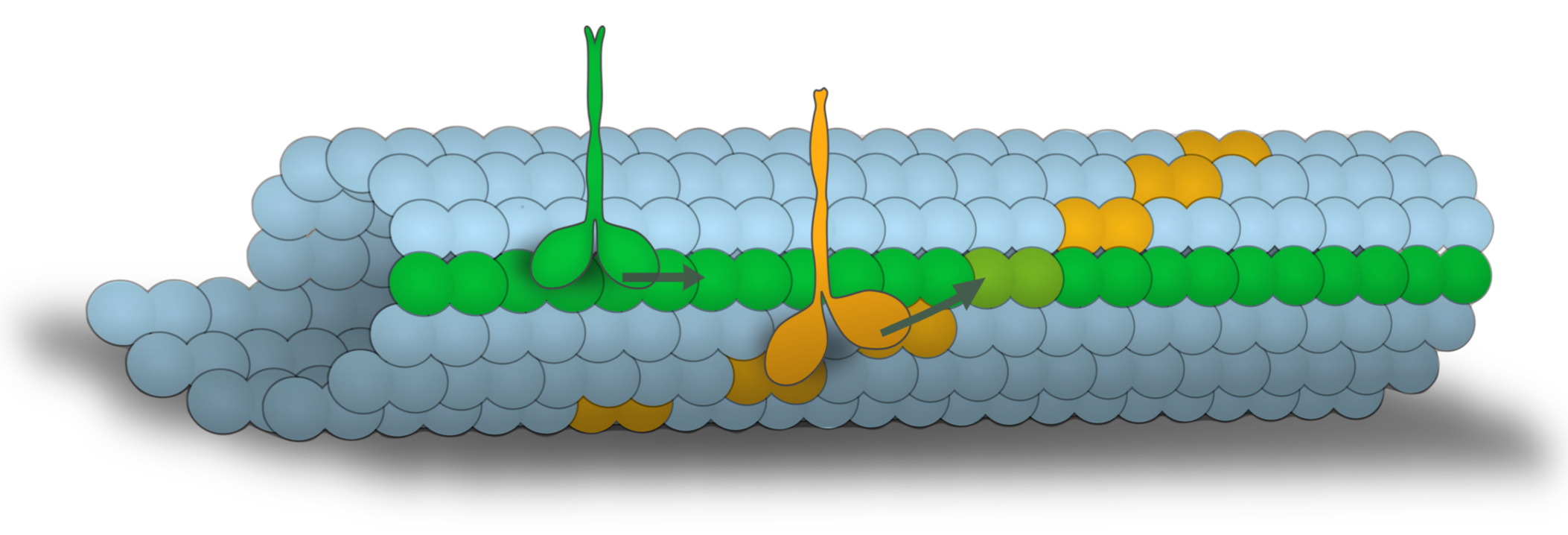Two-Species Active Transport along Cylindrical Biofilaments is Limited by Emergent Topological Hindrance
Patrick Wilke, Emanuel Reithmann and Erwin Frey
 Active transport by molecular motors along a filament is a vital process in cells. The motion of single motors has been studied in great detail and it has been shown that different species of motors often exhibit distinct stepping modes. For all super families of molecular motors (kinesins, dynein, and myosin) helical pathways with different pitches are probably the rule rather than the exception. But while their individual behavior is known in great detail, understanding their collective properties remains challenging. In this respect, a multitude of models based on the totally asymmetric simple exclusion process (TASEP) has by now established a clear picture of collective single species transport. However, as we have now shown, a mixed population of molecular motors with different gaits displays very distinctive collective behaviors that can not be accounted for by previous analyses and models.
Active transport by molecular motors along a filament is a vital process in cells. The motion of single motors has been studied in great detail and it has been shown that different species of motors often exhibit distinct stepping modes. For all super families of molecular motors (kinesins, dynein, and myosin) helical pathways with different pitches are probably the rule rather than the exception. But while their individual behavior is known in great detail, understanding their collective properties remains challenging. In this respect, a multitude of models based on the totally asymmetric simple exclusion process (TASEP) has by now established a clear picture of collective single species transport. However, as we have now shown, a mixed population of molecular motors with different gaits displays very distinctive collective behaviors that can not be accounted for by previous analyses and models.
Employing a two-dimensional lattice gas model we identify a specific type of topological amplification of steric hindrance as a central determinant of mixed species transport. In presence of the second species a given position may be accessible from more directions than are open for the present occupant to leave. This simple change in the network topology has substantial consequences for collective transport. Most prominently, it leads to global particle jamming far below full occupation of the lattice and to pattern formation. Our theory computes the strength of topologically amplified hindrance and provides a detailed picture of the emerging macroscopic properties. Moreover, our analysis is compatible with the results of the TASEP - the paradigm for single-species transport. The robustness and the impact of topologically amplified hindrance are proven in our work in several ways: First, we show that small fractions of the second species are sufficient to create large deviations in macroscopic observables. Second, we show that topological hindrance dominates collective behavior for a large range of system proportions. Third, the observed phenomenology is widely robust against biologically inspired model modifications.
On a broader scope, our study may also have a much wider impact on other fields of research. Our model constitutes not only a simple system far from thermal equilibrium that is understood in great analytic detail, it also features a novel phenomenology that enriches those of the TASEP, Katz-Lebowitz-Spohn, Nagel-Schreckenberg, or comparable models. Specifically, the observed pattern formation in the density profiles and a jamming transition driven by particle ordering are rarely observed effects in transport models which are of great interest in their own right. In this context, the analytic approaches developed in our manuscript can open up a route to deeper insights into these complex phenomena.

